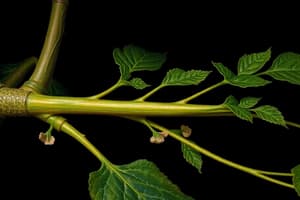Podcast
Questions and Answers
What is the primary function of xylem in plants?
What is the primary function of xylem in plants?
- Providing structural support to leaves
- Transporting sugars produced during photosynthesis
- Regulating gas exchange through stomata
- Transporting water and dissolved minerals (correct)
Phloem is composed of dead cells that transport nutrients throughout the plant.
Phloem is composed of dead cells that transport nutrients throughout the plant.
False (B)
What adaptation do some angiosperms have for efficient water conduction?
What adaptation do some angiosperms have for efficient water conduction?
Vessel elements
In plants, the __________ is responsible for the transport of organic nutrients, mainly sugars.
In plants, the __________ is responsible for the transport of organic nutrients, mainly sugars.
Match the following vascular tissue features with their descriptions:
Match the following vascular tissue features with their descriptions:
Flashcards are hidden until you start studying
Study Notes
Vascular Systems in Plants
-
Definition: Specialized tissue systems that transport water, nutrients, and sugars throughout the plant.
-
Key Components:
-
Xylem:
- Transports water and dissolved minerals from roots to other parts of the plant.
- Composed of dead cells (tracheids and vessel elements).
- Functions primarily through capillary action and transpiration pull.
-
Phloem:
- Transports organic nutrients, particularly sugars produced during photosynthesis.
- Composed of living cells (sieve-tube elements and companion cells).
- Functions through pressure flow mechanism, where positive pressure pushes sap from source to sink.
-
-
Arrangement:
- Vascular tissue is typically organized in vascular bundles.
- In stems, vascular bundles are arranged in a ring (dicots) or scattered (monocots).
- In roots, xylem is usually located at the center, surrounded by phloem.
-
Functions:
- Support: The rigid structure of xylem contributes to plant support and stability.
- Transport: Efficient movement of water, nutrients, and food throughout the plant.
- Regulation: Helps regulate water loss through stomata in leaves via transpiration.
-
Adaptations:
- Development of specialized xylem cells like vessel elements in some angiosperms for efficient water conduction.
- Phloem adapts to enhance nutrient translocation in response to seasonal changes and plant growth.
-
Comparison with Other Systems:
- Unlike animal circulatory systems, plant vascular systems operate primarily through passive mechanisms (except for phloem).
- Animals use a heart-driven circulatory system; plants rely on environmental factors for transport (e.g., gravity, capillarity).
-
Importance:
- Vital for plant health and growth.
- Supports photosynthesis by ensuring availability of water and nutrients.
- Critical for ecological interactions, contributing to energy flow in ecosystems.
Vascular Systems in Plants
- Specialized tissue systems that transport water, nutrients, and sugars throughout the plant.
- Composed of two main components: xylem and phloem.
Xylem
- Transports water and dissolved minerals from roots to other parts of the plant.
- Composed of dead cells, specifically tracheids and vessel elements.
- Functions primarily through capillary action and transpiration pull.
Phloem
- Transports organic nutrients, particularly sugars produced during photosynthesis.
- Composed of living cells, specifically sieve-tube elements and companion cells.
- Functions through pressure flow mechanism, where positive pressure pushes sap from source to sink.
Vascular Bundle Arrangement
- Vascular tissue is typically organized in vascular bundles.
- In stems, vascular bundles are arranged in a ring in dicotyledonous plants (dicots) or scattered in monocotyledonous plants (monocots).
- In roots, xylem is usually located at the center, surrounded by phloem.
Vascular System Functions
- Support: the rigid structure of xylem contributes to plant support and stability.
- Transport: efficient movement of water, nutrients, and food throughout the plant.
- Regulation: helps regulate water loss through stomata in leaves via transpiration.
Vascular System Adaptations
- Development of specialized xylem cells like vessel elements in some angiosperms for efficient water conduction.
- Phloem adapts to enhance nutrient translocation in response to seasonal changes and plant growth.
### Comparison with Other Systems
- Unlike animal circulatory systems, plant vascular systems operate primarily through passive mechanisms (except for phloem).
- Animals use a heart-driven circulatory system; plants rely on environmental factors for transport (e.g., gravity, capillarity).
Importance
- Vital for plant health and growth.
- Supports photosynthesis by ensuring availability of water and nutrients.
- Critical for ecological interactions, contributing to energy flow in ecosystems.
Studying That Suits You
Use AI to generate personalized quizzes and flashcards to suit your learning preferences.




